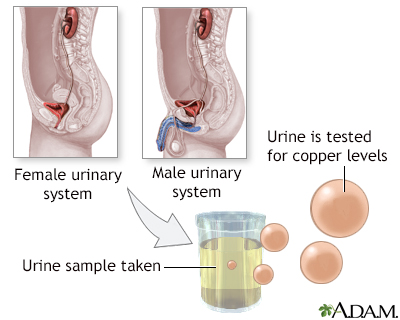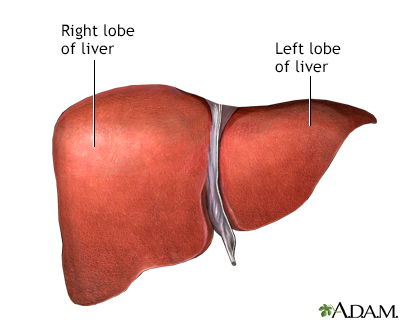Wilson disease
Wilson's disease; Hepatolenticular degeneration
Wilson disease is an inherited disorder in which there is too much copper in the body's tissues. The excess copper damages the liver and nervous system.
Images



Causes
Wilson disease is a rare inherited disorder. If both parents carry a non-working (variant) gene for Wilson disease, there is a 25% chance in each pregnancy that the child will have the disorder.
Wilson disease causes the body to take in and keep too much copper. The copper deposits in the liver, brain, kidneys, and eyes. This causes tissue damage, tissue death, and scarring. The affected organs stop working normally.
This condition is most common in eastern Europeans, Sicilians, and southern Italians, but it may occur in any group. Wilson disease symptoms typically appear in people under 40 years old. Damage to the liver may begin in children by age 6, but clinical symptoms most often appear in people in their teens or early twenties.
Symptoms
Symptoms may include:
- Abnormal posture of arms and legs
- Arthritis
- Confusion or delirium
- Dementia
- Difficulty moving arms and legs, stiffness
- Difficulty walking (ataxia)
- Emotional or behavioral changes
- Enlargement of the abdomen due to accumulation of fluid (ascites)
- Personality changes
- Phobias
- Slow movements
- Slow or decreased movement and expressions of the face
- Speech impairment
- Tremors of the arms or hands
- Uncontrollable movement
- Unpredictable and jerky movement
- Vomiting blood
- Weakness
- Yellow skin (jaundice) or yellow color of the white of the eye (icterus)
Exams and Tests
A slit-lamp eye exam may show:
- Limited eye movement
- Rusty or brown-colored ring around the iris (Kayser-Fleischer rings)
A physical exam may show signs of:
- Damage to the central nervous system, including loss of coordination, loss of muscle control, muscle tremors, loss of thinking and IQ, loss of memory, and confusion (delirium or dementia)
- Liver or spleen disorders (including an enlarged liver or spleen)
Lab tests may include:
- Complete blood count (CBC)
- Serum ceruloplasmin
- Serum copper
- Serum uric acid
- Urine copper
If there are liver problems, lab tests may find:
Other tests may include:
- 24-hour urine copper test
- Abdominal x-ray
- Abdominal MRI
- CT scan of the abdomen
- Head CT scan
- Head MRI
- Liver biopsy
- Upper GI endoscopy
Non-working copies of the gene called ATP7B causes Wilson disease. DNA testing is available for this gene. Talk to your health care provider or a genetic counselor to learn if you should have gene testing performed.
Treatment
The goal of treatment is to reduce the amount of copper in the tissues. This is done by a procedure called chelation. Certain medicines are given that bind to copper and help remove it through the kidneys or gut. Treatment must be lifelong.
The following medicines may be used:
- Penicillamine (such as Cuprimine, Depen) binds to copper and leads to increased release of copper in the urine.
- Trientine (such as Syprine) binds (chelates) the copper and increases its release through the urine.
- Zinc acetate (such as Galzin) blocks copper from being absorbed in the intestinal tract.
Vitamin E supplements may also be used.
Sometimes, medicines that chelate copper (such as penicillamine) can affect the function of the brain and nervous system (neurological function). Other medicines under investigation may bind copper without affecting neurological function.
A low-copper diet may also be recommended. Foods to avoid include:
- Chocolate
- Dried fruit
- Liver
- Mushrooms
- Nuts
- Shellfish
You may want to drink distilled water because some tap water flows through copper pipes. Avoid using copper cooking utensils.
Symptoms may be managed with exercise or physical therapy. People who are confused or unable to care for themselves may need special protective measures.
A liver transplant may be considered in cases where the liver is severely damaged by the disease.
Support Groups
More information and support for people with Wilson disease and their families can be found at:
- Wilson Disease Association: - wilsondisease.org
- Genetic Alliance: - geneticalliance.org
Outlook (Prognosis)
Lifelong treatment is needed to control Wilson disease. The disease may cause fatal effects, such as loss of liver function. Copper can have toxic effects on the nervous system. In cases where the disease is not fatal, symptoms may be disabling.
Possible Complications
Complications may include:
- Anemia (hemolytic anemia is rare)
- Central nervous system complications
- Cirrhosis
- Death of liver tissues
- Fatty liver
- Hepatitis
- Increased chances of bone fractures
- Increased number of infections
- Injury caused by falls
- Jaundice
- Joint contractures or other deformity
- Loss of ability to care for self
- Loss of ability to function at work and home
- Loss of ability to interact with other people
- Loss of muscle mass (muscle atrophy)
- Psychological complications
- Side effects of penicillamine and other medicines used to treat the disorder
- Spleen problems
Liver failure and damage to the central nervous system (brain, spinal cord) are the most common and dangerous effects of the disorder. If the disease is not caught and treated early, it can be fatal.
When to Contact a Medical Professional
Contact your provider if you have symptoms of Wilson disease. Contact a genetic counselor if you have a history of Wilson disease in your family and you are planning to have children.
Prevention
Genetic counseling is recommended for people with a personal or family history of Wilson disease.
Related Information
Liver diseaseHepatitis B
Cirrhosis
Anemia
Contracture deformity
References
National Institute of Diabetes and Digestive and Kidney Diseases website. Wilson disease. www.niddk.nih.gov/health-information/liver-disease/wilson-disease/definition-facts. Updated October 2018. Accessed September 13, 2024.
Roberts EA. Wilson disease. In: Feldman M, Friedman LS, Brandt LJ, eds. Sleisenger and Fordtran's Gastrointestinal and Liver Disease. 11th ed. Philadelphia, PA: Elsevier; 2021:chap 76.
Schilsky ML. Wilson disease. In: Goldman L, Cooney KA, eds. Goldman-Cecil Medicine. 27th ed. Philadelphia, PA: Elsevier; 2024:chap 195.
BACK TO TOPReview Date: 8/18/2024
Reviewed By: Anna C. Edens Hurst, MD, MS, Associate Professor in Medical Genetics, The University of Alabama at Birmingham, Birmingham, AL. Review provided by VeriMed Healthcare Network. Also reviewed by David C. Dugdale, MD, Medical Director, Brenda Conaway, Editorial Director, and the A.D.A.M. Editorial team.

Health Content Provider
06/01/2025
|
A.D.A.M., Inc. is accredited by URAC, for Health Content Provider (www.urac.org). URAC's accreditation program is an independent audit to verify that A.D.A.M. follows rigorous standards of quality and accountability. A.D.A.M. is among the first to achieve this important distinction for online health information and services. Learn more about A.D.A.M.'s editorial policy, editorial process and privacy policy. A.D.A.M. is also a founding member of Hi-Ethics. This site complied with the HONcode standard for trustworthy health information from 1995 to 2022, after which HON (Health On the Net, a not-for-profit organization that promoted transparent and reliable health information online) was discontinued. |
The information provided herein should not be used during any medical emergency or for the diagnosis or treatment of any medical condition. A licensed medical professional should be consulted for diagnosis and treatment of any and all medical conditions. Links to other sites are provided for information only -- they do not constitute endorsements of those other sites. © 1997- 2025 A.D.A.M., a business unit of Ebix, Inc. Any duplication or distribution of the information contained herein is strictly prohibited.
